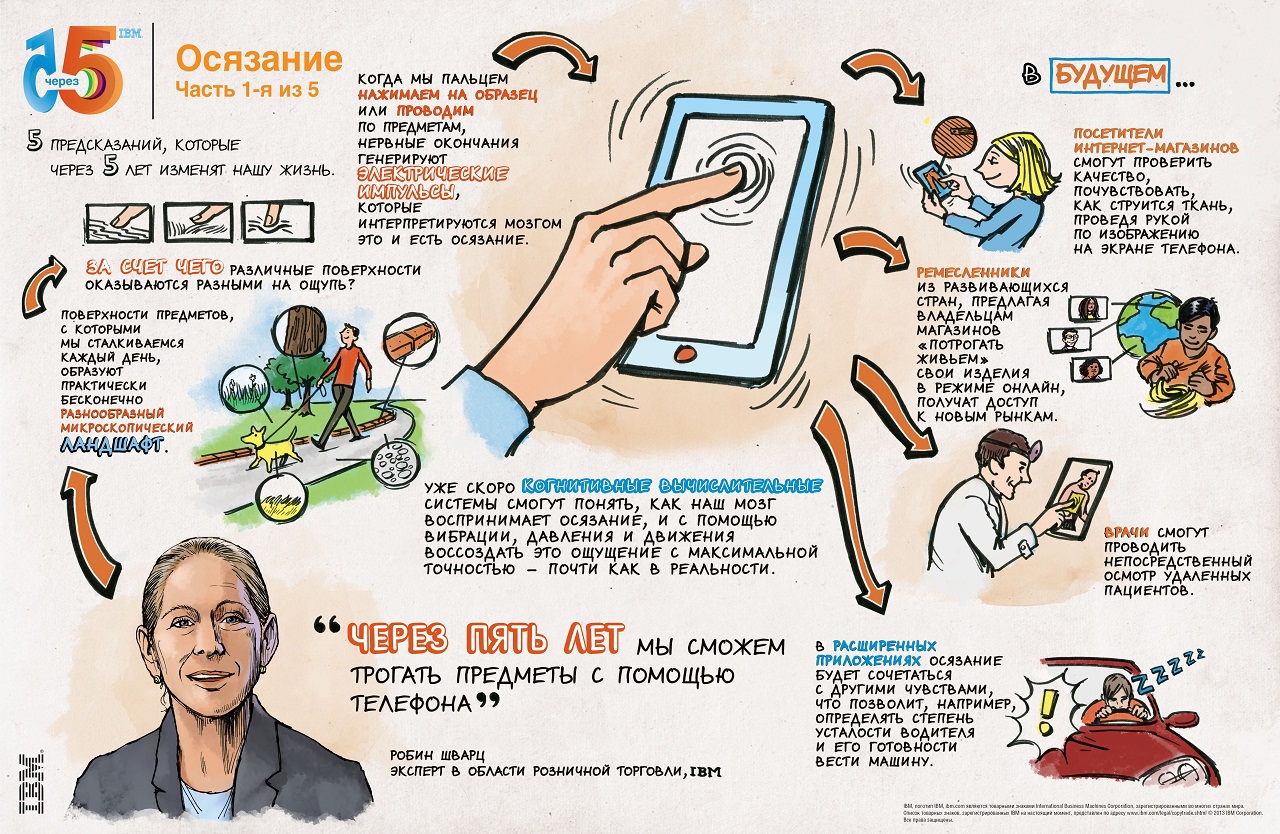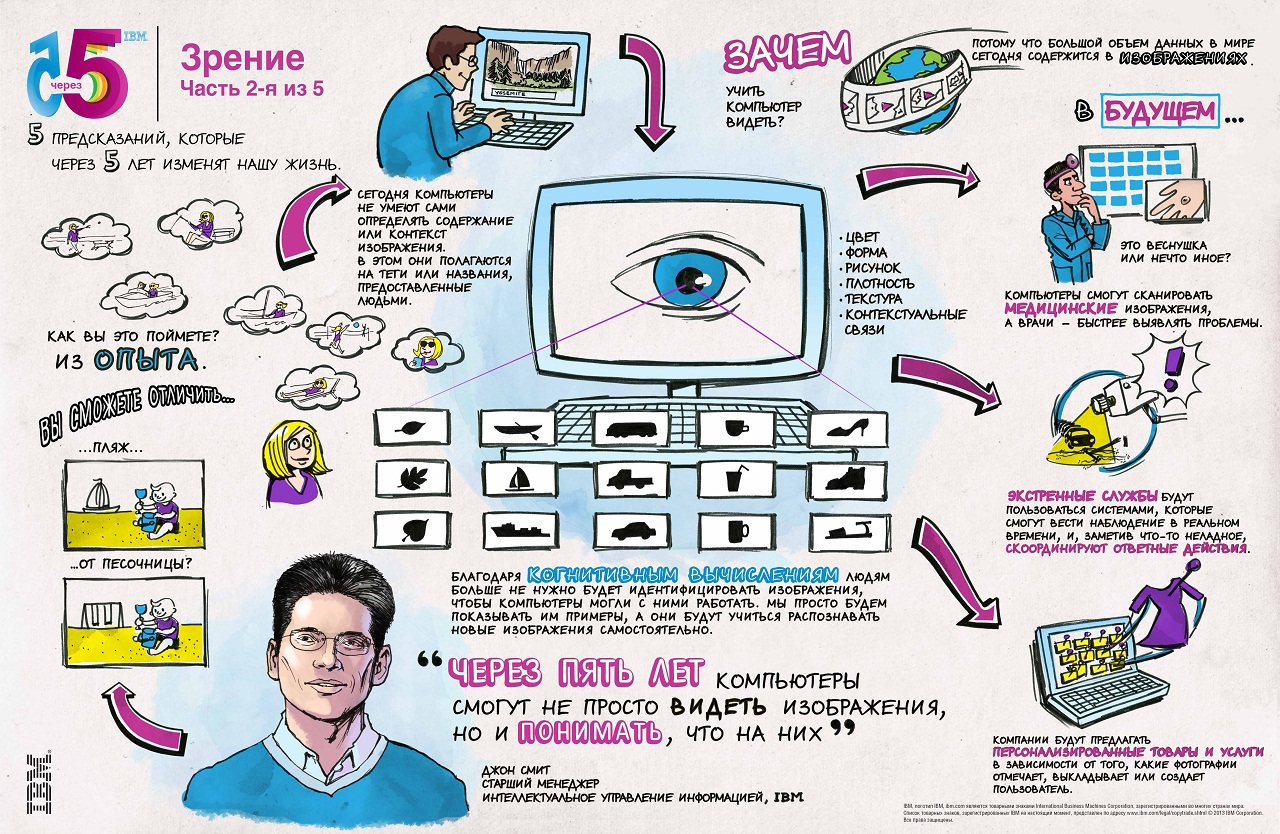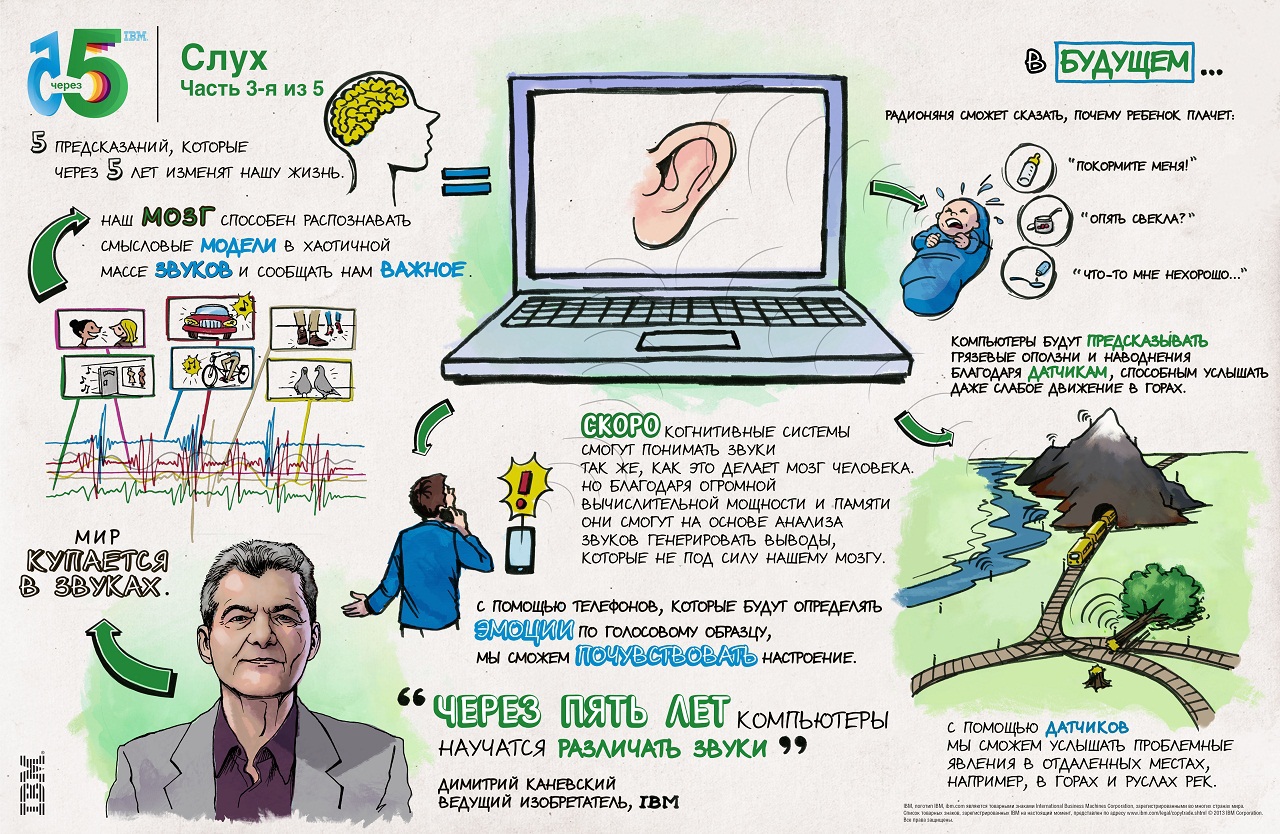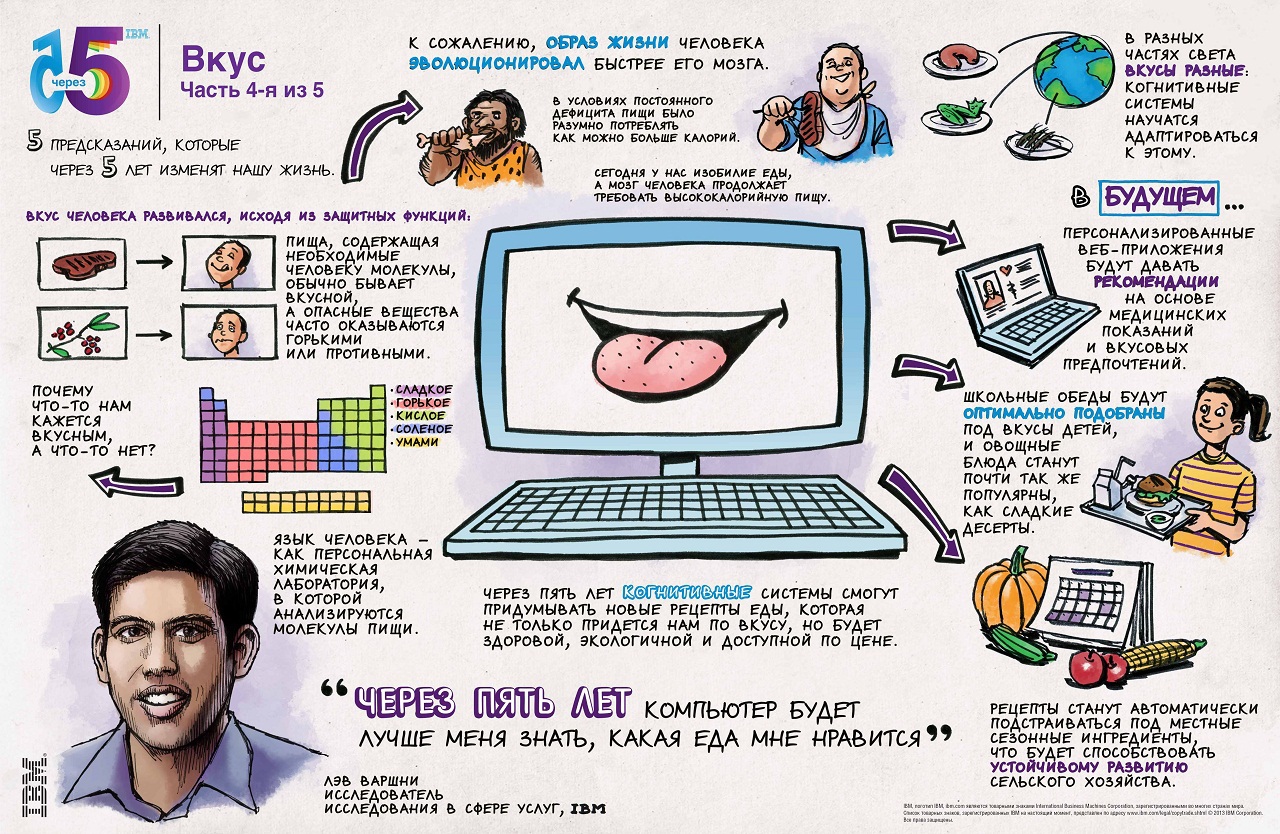"IBM 5 in 5". Is the future near?
How much can technology transform in 5 years? And will they make our life better?
In anticipation of the new year 2013, we want to present the seventh annual list of “IBM 5 in 5”, dedicated to five innovations that can affect our life, work and entertainment in the next 5 years.

The IBM 5 in 5 list is based on market and social trends, as well as on the development of IBM research laboratories around the world that can help in their implementation.
This year's IBM 5 in 5 list features innovations that shape the principles of a new generation of computing systems that IBM calls cognitive. Cognitive machines will learn, adapt and develop a full-fledged perception of the world. This year, forecasts are devoted to the ability of computers of the future to imitate the human senses, i.e. in your own way to see, hear, feel, perceive smells and taste.
 Cognitive computing systems will help to highlight the key in the data, keep pace with the speed of their dissemination, make better decisions, improve health and improve living standards, diversify life and remove any obstacles and barriers: geographical, linguistic, related to the cost and availability of services.
Cognitive computing systems will help to highlight the key in the data, keep pace with the speed of their dissemination, make better decisions, improve health and improve living standards, diversify life and remove any obstacles and barriers: geographical, linguistic, related to the cost and availability of services.
“IBM scientists around the world are working on technologies that help computers understand the meaning of the world,” said Bernie Meyerson, IBM Emeritus and Vice President of Innovation. “By simulating human interaction with the world around us, cognitive systems, using a combination of breakthrough technologies, will bring us even more valuable information and knowledge, helping to solve the most complex problems.”

Imagine buying a suit using a smartphone in an online store, you can feel the texture of the fabric using the touch screen of a mobile device. Over the next five years, the ability to “touch” a product through a mobile device will literally transform entire industries, such as retail.
IBM scientists are developing applications for retail, healthcare and other industries, using tactile sensing, infrared light and pressure sensitivity technologies to simulate touch, so that a customer can swipe the fabric texture and patterns by swiping her finger on the image on the screen of her mobile device. The standard vibration function of a cell phone allows each object to be assigned a unique set of vibrational characteristics (associated with their duration and strength) that will transmit tactile sensations. The vibration pattern will distinguish silk from linen or cotton, helping to simulate the sensation of touching the material.
Existing tactile and graphic technologies in the gaming industry are used to create a virtual environment. The task, the solution of which will open up the widest possibilities, is to make these technologies comprehensive, closely integrated into our daily lives. They will turn mobile phones into tools for a natural and intuitive interaction with the outside world.

We take 500 billion photos a year. Every minute, 72 hours of video are uploaded to YouTube. According to experts, the market for medical diagnostic imaging tools will grow to $ 26.6 billion by 2016.
Computers today understand the meaning of an image only by text tags and name. The bulk of the information — the actual content of the image — remains a mystery to computers.
In the next five years, computer systems will not only learn to recognize what is depicted in a photograph or picture - they will understand the meaning of the image, as a person does. In the future, these capabilities will allow computers to analyze a variety of characteristics: the color of an object or a pattern on its surface, tangible boundaries, in general - to obtain knowledge from visual data. These technologies will have a major impact on healthcare, retail and agriculture.
Over the course of five years, these opportunities will find application in healthcare, where they will help to obtain valuable knowledge from medical data arrays - MRI images and computed tomography, X-ray images and ultrasound results. It is important that these images may contain subtle or invisible to the human eye details that require careful study. With the ability to highlight the key in images - for example, to distinguish between healthy tissues and those affected by the disease - and to correlate information with the patient’s medical history or with descriptions in the scientific literature, “sighted” computer systems will help doctors identify clinical problems with much greater speed and accuracy.

Have you ever regretted that it is impossible to hear all the sounds of the world and understand what is hidden behind the intonations of the interlocutor?
Within five years, a distributed network of smart sensors will be presented to determine sound pressure and vibrations, as well as distinguish sound waves at different frequencies. She will be able to interpret sounds to calculate the risks of falling trees in the forest or avalanche in the mountains. Such a system will “listen” to the outside world, determining movements or noting the degree of stress of materials, and alert us to potential dangers.
Sounds of the surrounding world will be perceived by sensors that mimic the auditory system. This information, combined with other types of data, such as visual or tactile information, will be classified and interpreted in accordance with acquired knowledge. When new sounds are detected, the system will formulate conclusions, guided by previous knowledge and using the ability to recognize patterns.
For example, it will be possible to interpret children's speech so that the parents or the doctor understand what the child is trying to convey. Learning what these sounds mean - when they indicate that the child is hungry, tired, feels hot, uncomfortable, or pain - an intelligent speech recognition system will correlate them with other sensory or physiological data, such as heart rate and body temperature.
In the next five years, computer systems will be able to accurately capture all the characteristics of the conversation and analyze the tone, timbre, uncertainty in the voice, focusing on changes in the emotional mood. This will allow, for example, to optimally organize the communication of contact center personnel with customers or to facilitate the interaction of representatives of different cultures.
Currently, IBM scientists are beginning to use underwater sensors that detect noise in Galway Bay (off the west coast of Ireland) to interpret the sounds of a generator using tidal energy, as well as to study the effect of acoustics on the life of the sea.

What if we could give healthy food a good taste by creating new recipes using next-generation computers?
IBM researchers are developing a computer system that can truly experience the taste; it will be used by chefs to create innovative recipes. It will “break down” the ingredients to their molecular level and formulate chemical compositions of food compounds, taking into account the taste and aromatic preferences of people. Comparing these combinations with millions of existing recipes, the system will be able to create new flavor combinations - for example, roasted chestnuts with boiled beets, fresh fish caviar or dried ham.
A similar system can also help to eat better, creating new combinations of smells that make us fall in love with vegetables and refuse potato chips.
The computer will use complex algorithms to determine the exact chemical structure of food products, as well as to study taste preferences. These algorithms will study how chemicals interact with each other, find out their taste components at the molecular level, and use this information in combination with perception models to predict the palatability of a product.
Such a system will not only help to make healthy food more enjoyable, it will also surprise you with unusual combinations of products created for the most vivid taste sensations. For people with a special diet, in particular those with diabetes, the system will develop special flavor combinations and recipes that will allow you to control blood sugar and, at the same time, satisfy cravings for sweets.

In the next five years, tiny sensors built into a computer or mobile phone will be able to detect symptoms of the common cold or other illnesses. By analyzing odors, biomarkers, and thousands of molecules in human breathing and correlating them with the norm, computer systems will help doctors diagnose and monitor diseases such as impaired liver and kidney function, asthma, diabetes, and epilepsy.
Today, IBM scientists are already monitoring environmental performance to preserve works of art. This innovative method is also beginning to be applied in the field of clinical hygiene to solve one of the biggest problems healthcare faces today. Antibiotic-resistant bacteria, such as methicillin-resistant Staphylococcus aureus (MRSA), which in 2005 was associated with nearly 19 thousand deaths from patients in US hospitals, are usually located on the skin and can be easily transmitted wherever people are in close contact together. One of the preventive ways to combat the impact and spread of MRSA in hospitals is to strictly monitor compliance by medical personnel with established regulatory requirements for clinical hygiene. In the next five years, a system based on IBM technology will be used to study hospital rooms and other rooms for signs of disinfectants to identify places that have not yet been sanitized. Intelligent sensors will use the latest wireless networks to collect and analyze data on various chemicals, and constantly self-learn and adapt to new odors.
Thanks to the development of sensor, telecommunication and self-learning technologies, sensors will be able to collect and analyze data where it was considered unavailable. In particular, computer systems can be used in agriculture to detect odors and analyze soil conditions in crops. In urban environments, this technology will be used to monitor the sanitary status and pollution levels of territories and premises, helping city services identify potential problems before they cause real damage.
Additional materials are available here .
In anticipation of the new year 2013, we want to present the seventh annual list of “IBM 5 in 5”, dedicated to five innovations that can affect our life, work and entertainment in the next 5 years.

The IBM 5 in 5 list is based on market and social trends, as well as on the development of IBM research laboratories around the world that can help in their implementation.
This year's IBM 5 in 5 list features innovations that shape the principles of a new generation of computing systems that IBM calls cognitive. Cognitive machines will learn, adapt and develop a full-fledged perception of the world. This year, forecasts are devoted to the ability of computers of the future to imitate the human senses, i.e. in your own way to see, hear, feel, perceive smells and taste.
 Cognitive computing systems will help to highlight the key in the data, keep pace with the speed of their dissemination, make better decisions, improve health and improve living standards, diversify life and remove any obstacles and barriers: geographical, linguistic, related to the cost and availability of services.
Cognitive computing systems will help to highlight the key in the data, keep pace with the speed of their dissemination, make better decisions, improve health and improve living standards, diversify life and remove any obstacles and barriers: geographical, linguistic, related to the cost and availability of services.“IBM scientists around the world are working on technologies that help computers understand the meaning of the world,” said Bernie Meyerson, IBM Emeritus and Vice President of Innovation. “By simulating human interaction with the world around us, cognitive systems, using a combination of breakthrough technologies, will bring us even more valuable information and knowledge, helping to solve the most complex problems.”
Touch: Phone interface can convey tactile sensations.

Imagine buying a suit using a smartphone in an online store, you can feel the texture of the fabric using the touch screen of a mobile device. Over the next five years, the ability to “touch” a product through a mobile device will literally transform entire industries, such as retail.
IBM scientists are developing applications for retail, healthcare and other industries, using tactile sensing, infrared light and pressure sensitivity technologies to simulate touch, so that a customer can swipe the fabric texture and patterns by swiping her finger on the image on the screen of her mobile device. The standard vibration function of a cell phone allows each object to be assigned a unique set of vibrational characteristics (associated with their duration and strength) that will transmit tactile sensations. The vibration pattern will distinguish silk from linen or cotton, helping to simulate the sensation of touching the material.
Existing tactile and graphic technologies in the gaming industry are used to create a virtual environment. The task, the solution of which will open up the widest possibilities, is to make these technologies comprehensive, closely integrated into our daily lives. They will turn mobile phones into tools for a natural and intuitive interaction with the outside world.
Vision: The sense of pixels will be available to computers

We take 500 billion photos a year. Every minute, 72 hours of video are uploaded to YouTube. According to experts, the market for medical diagnostic imaging tools will grow to $ 26.6 billion by 2016.
Computers today understand the meaning of an image only by text tags and name. The bulk of the information — the actual content of the image — remains a mystery to computers.
In the next five years, computer systems will not only learn to recognize what is depicted in a photograph or picture - they will understand the meaning of the image, as a person does. In the future, these capabilities will allow computers to analyze a variety of characteristics: the color of an object or a pattern on its surface, tangible boundaries, in general - to obtain knowledge from visual data. These technologies will have a major impact on healthcare, retail and agriculture.
Over the course of five years, these opportunities will find application in healthcare, where they will help to obtain valuable knowledge from medical data arrays - MRI images and computed tomography, X-ray images and ultrasound results. It is important that these images may contain subtle or invisible to the human eye details that require careful study. With the ability to highlight the key in images - for example, to distinguish between healthy tissues and those affected by the disease - and to correlate information with the patient’s medical history or with descriptions in the scientific literature, “sighted” computer systems will help doctors identify clinical problems with much greater speed and accuracy.
Rumor: Computers will hear what is happening around

Have you ever regretted that it is impossible to hear all the sounds of the world and understand what is hidden behind the intonations of the interlocutor?
Within five years, a distributed network of smart sensors will be presented to determine sound pressure and vibrations, as well as distinguish sound waves at different frequencies. She will be able to interpret sounds to calculate the risks of falling trees in the forest or avalanche in the mountains. Such a system will “listen” to the outside world, determining movements or noting the degree of stress of materials, and alert us to potential dangers.
Sounds of the surrounding world will be perceived by sensors that mimic the auditory system. This information, combined with other types of data, such as visual or tactile information, will be classified and interpreted in accordance with acquired knowledge. When new sounds are detected, the system will formulate conclusions, guided by previous knowledge and using the ability to recognize patterns.
For example, it will be possible to interpret children's speech so that the parents or the doctor understand what the child is trying to convey. Learning what these sounds mean - when they indicate that the child is hungry, tired, feels hot, uncomfortable, or pain - an intelligent speech recognition system will correlate them with other sensory or physiological data, such as heart rate and body temperature.
In the next five years, computer systems will be able to accurately capture all the characteristics of the conversation and analyze the tone, timbre, uncertainty in the voice, focusing on changes in the emotional mood. This will allow, for example, to optimally organize the communication of contact center personnel with customers or to facilitate the interaction of representatives of different cultures.
Currently, IBM scientists are beginning to use underwater sensors that detect noise in Galway Bay (off the west coast of Ireland) to interpret the sounds of a generator using tidal energy, as well as to study the effect of acoustics on the life of the sea.
Taste: Digital taste buds help you eat smarter

What if we could give healthy food a good taste by creating new recipes using next-generation computers?
IBM researchers are developing a computer system that can truly experience the taste; it will be used by chefs to create innovative recipes. It will “break down” the ingredients to their molecular level and formulate chemical compositions of food compounds, taking into account the taste and aromatic preferences of people. Comparing these combinations with millions of existing recipes, the system will be able to create new flavor combinations - for example, roasted chestnuts with boiled beets, fresh fish caviar or dried ham.
A similar system can also help to eat better, creating new combinations of smells that make us fall in love with vegetables and refuse potato chips.
The computer will use complex algorithms to determine the exact chemical structure of food products, as well as to study taste preferences. These algorithms will study how chemicals interact with each other, find out their taste components at the molecular level, and use this information in combination with perception models to predict the palatability of a product.
Such a system will not only help to make healthy food more enjoyable, it will also surprise you with unusual combinations of products created for the most vivid taste sensations. For people with a special diet, in particular those with diabetes, the system will develop special flavor combinations and recipes that will allow you to control blood sugar and, at the same time, satisfy cravings for sweets.
Smell: Computers will gain a sense of smell

In the next five years, tiny sensors built into a computer or mobile phone will be able to detect symptoms of the common cold or other illnesses. By analyzing odors, biomarkers, and thousands of molecules in human breathing and correlating them with the norm, computer systems will help doctors diagnose and monitor diseases such as impaired liver and kidney function, asthma, diabetes, and epilepsy.
Today, IBM scientists are already monitoring environmental performance to preserve works of art. This innovative method is also beginning to be applied in the field of clinical hygiene to solve one of the biggest problems healthcare faces today. Antibiotic-resistant bacteria, such as methicillin-resistant Staphylococcus aureus (MRSA), which in 2005 was associated with nearly 19 thousand deaths from patients in US hospitals, are usually located on the skin and can be easily transmitted wherever people are in close contact together. One of the preventive ways to combat the impact and spread of MRSA in hospitals is to strictly monitor compliance by medical personnel with established regulatory requirements for clinical hygiene. In the next five years, a system based on IBM technology will be used to study hospital rooms and other rooms for signs of disinfectants to identify places that have not yet been sanitized. Intelligent sensors will use the latest wireless networks to collect and analyze data on various chemicals, and constantly self-learn and adapt to new odors.
Thanks to the development of sensor, telecommunication and self-learning technologies, sensors will be able to collect and analyze data where it was considered unavailable. In particular, computer systems can be used in agriculture to detect odors and analyze soil conditions in crops. In urban environments, this technology will be used to monitor the sanitary status and pollution levels of territories and premises, helping city services identify potential problems before they cause real damage.
Additional materials are available here .
Only registered users can participate in the survey. Please come in.
In your opinion, will these technologies appear within 5 years?
- 17.2% No, it's all from the category of science fiction 67
- 12.8% Yes, I admire the speed of development of modern technologies 50
- 26.4% Yes, but after 5 years, these technologies will be available only to a select few 103
- 43.4% Yes, but implementation takes more time 169
